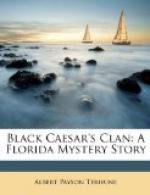Title: Black Caesar’s Clan
Author: Albert Payson Terhune
Release Date: December, 2003 [EBook #4789] [Yes, we are more than one year ahead of schedule] [This file was first posted on March 20, 2002]
Edition: 10
Language: English
Character set encoding: ASCII
*** Start of the project gutenberg EBOOK black Caesar’s clan ***
This book is dedicated, most
gratefully
to my friend
John E. Pickett
editor of
“The country Gentleman”
FOREWORD
A wiggling, brainless, slimy atom began it. He and trillions of his kind. He was the Coral Worm ("Anthozoa,” if you prefer).
He and his tribe lived and died on the sea-bottom, successive generations piling higher on the skeletons and lifework—or the life-loafing, for they were lazy atoms—of those that went before. At last the coral reef crawled upward until in uncharted waters it was tall enough to smash a wooden ship-keel.
Then, above the surface of the waves it nosed its way, grayish white, whalebacked. From a hundred miles distant floated a cigar-shaped mangrove-bud, bobbing vertically, through the ocean, until it chanced to touch the new-risen coral reef. The mangrove, alone of all trees, will sprout and grow in salt water. The mangrove’s trunk, alone of all trunks, is impervious to the corrosive action of the sea.
At once the bud set to work. It drove an anchor-root into the reef, then other roots and still others. It shot up to the height of a foot or two, and thence sent thick red-brown roots straight downward into the coral again.
And so on, until it had formed a tangled root-fence for many yards alongshore. After which, its work being done, the mangrove proceeded to grow upward into a big and glossy-leaved shade-tree, making buds for further fences.
Meanwhile, every particle of floating seaweed, every dead fish or animal, all vegetation, etc., which chanced to wash into that fence-tangle, stayed there. It is easier for matter, as well as for man, to get entangled in mangrove roots than to get out again.
The sun and the rain did their work on this decaying stuff. Thus, soil was formed, atop the coral and in the hollows scooped out of its surface by wind or tide.
Presently, a coconut, hurled from its stem in the Bahamas or in Cuba, by a hurricane, set its palmleaf sail-sprout and was gale-driven across the intervening seas, floating ashore on the new-risen land. There it sprouted. Birds, winds, waves, brought germs of other trees. The subtropical island was complete.
Island, key, reef—reef, key, island—with the intervening gaps of azure-emerald water, bridged, bit by bit, by the coral,—to-day a sea-surface, to-morrow a gray-white reef, next day a mangrove hedge, and the next an expanse of spectacular verdure and glistening gray-white sand.




